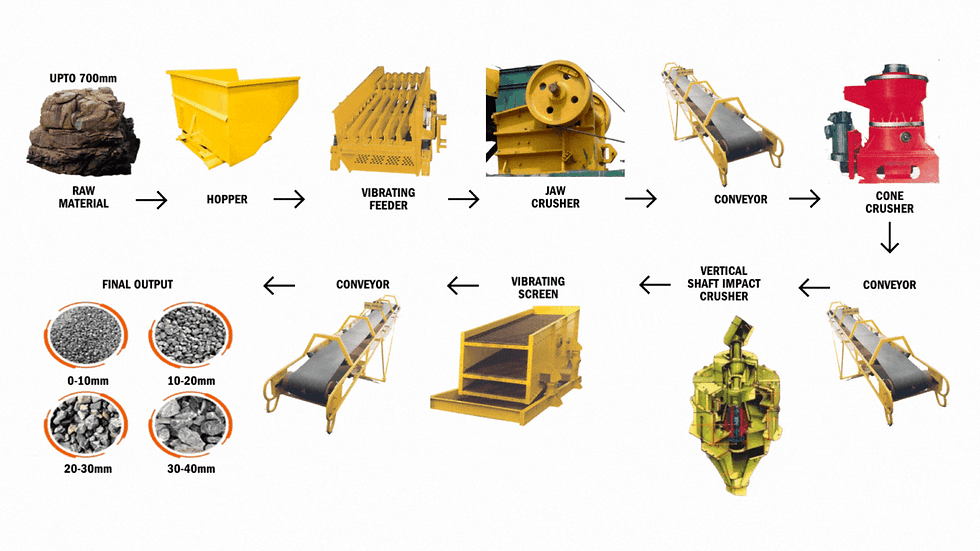Iron Ore Processing : Flow charts
- Prakash Agarwal
- Jul 29, 2024
- 3 min read
Iron ore is a key ingredient in making steel. In fact, about 98% of the iron ore that’s mined goes into steel production. There are two main methods for this: the blast furnace-basic oxygen furnace (BF-BOF) method and the electric arc furnace (EAF) method. Most steel in the world is produced using the BF-BOF method.
Types of Iron Ore
Iron ores that have a lot of hematite (over 60% iron) are called "natural ore" or DSO (Direct Shipping Ore). These can be used directly in the BF-BOF method. However, lower-grade ores need to be processed first. To prepare these ores, they go through crushing and screening to separate the valuable iron from the waste material.
Iron ore operations typically involve multiple stages of crushing and screening to separate materials based on size as quickly as possible. The goal is to remove lump products (sized between 6.3 mm and 31.5 mm) early on since they are more valuable than fines (less than 6.3 mm). Additionally, iron ore often comes from various sources, like satellite pits, which may have different qualities. These ores can be processed differently or blended to meet specific product requirements.
Rio Tinto Iron Ore Processing Plants
Location: Pilbara region, Western Australia
Processing Method: Dry processing, no chemical treatment
Crushing Stages:
Brockman 2:
Two-stage crushing (jaw crusher for primary, cone crushers for secondary).
Screening: Three stages (scalping screens before primary crushing, primary screens before secondary crushing, product screens for lump and fines separation).
Product Handling: Low-grade fines are stockpiled.
Mount Tom Price:
Three-stage crushing (gyratory for primary, cone for secondary and tertiary).
Screening: Two stages (scalping screens before secondary crushing, product screens for lump and fines).
Product Handling: Low-grade ores go through wet plants to improve quality.
Key Takeaway: Rio Tinto uses a combination of dry and wet processing, with a focus on maximizing lump product recovery. The choice of crushers varies based on the mine's geology, and they implement multiple screening stages to efficiently separate products.

Flow sheet of the Rio Tinto Brockman 2 processing plant in West Australia

Flow sheet of the Mount Tom Price processing plant in West Australia
BHP Newman Iron Ore Handling Hub
Location: Newman, Western Australia
Processing Method: Tertiary crushing and screening
Crushing Stages:
Three tertiary crushers.
Screening:
Five scalping screens and eight product screens.
Scalping screens remove fines before tertiary crushing.
Product screens separate lump and fines after crushing.
Blending: Ores from multiple sources are blended in a coarse ore stockpile before processing.
Key Takeaway: The Newman Hub emphasizes blending ores from different sources to ensure a consistent product. The use of multiple scalping and product screens helps maximize efficiency and separation of desired sizes.

Flowsheet of the BHP Newman Hub in Pilbara, West Australia
Roy Hill Operation
Location: Western Australia
Processing Method: Wet processing and beneficiation
Crushing Stages:
Three primary/secondary crushing stations, each crushing 5,000 tons per hour.
Screening:
Wet scrubbing and screening to remove clay and improve ore quality.
Oversize ore (>40 mm) is sent to tertiary crushers.
Different stockpiles for lump (8-40 mm), fines (1-8 mm), and very fine material (<1 mm).
Key Takeaway: Roy Hill’s operation is designed for wet processing due to the nature of the ore. This setup is more intensive and complex, focusing on maximizing product quality through multiple stages of crushing and screening.

Flowsheet of the Final Roy Hill processing
Vale S11D Project
Location: Carajas, Amazon region, Brazil
Processing Method: Modular ore crushing and screening
Crushing Stages:
Advanced vibrating screens designed to handle sticky ore.
Screening:
Initially considered wet screening but opted for dry methods to avoid high costs.
Engaged a supplier to provide large, double-deck eccentric screens for efficient processing.
Key Takeaway: Vale’s S11D project addresses unique challenges posed by the humid environment and sticky ore. The decision to use advanced vibrating screens instead of wet screening reflects a focus on efficiency and cost-effectiveness.
Mobile Crushing and Screening Plants
Location: Various, suitable for small to medium-sized projects
Processing Method: Mobile systems for flexibility and reduced truck haulage
Crushing Stages: Varies by design, typically includes primary and secondary crushing.
Screening: Mobile screens that can be easily relocated.
Key Takeaway: Mobile crushing and screening plants offer flexibility and lower capital costs, making them ideal for projects with resources spread over larger distances. However, they may not be suitable for large, long-term operations or challenging climates.




Comments